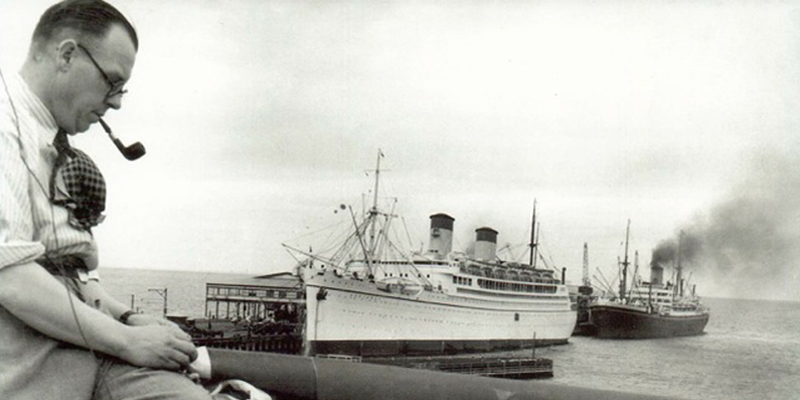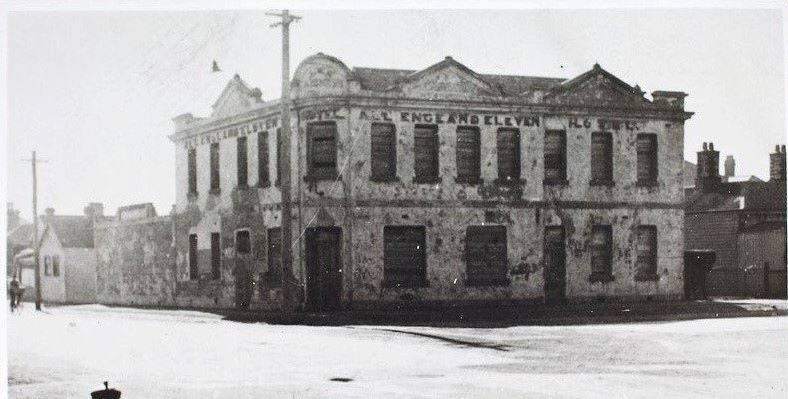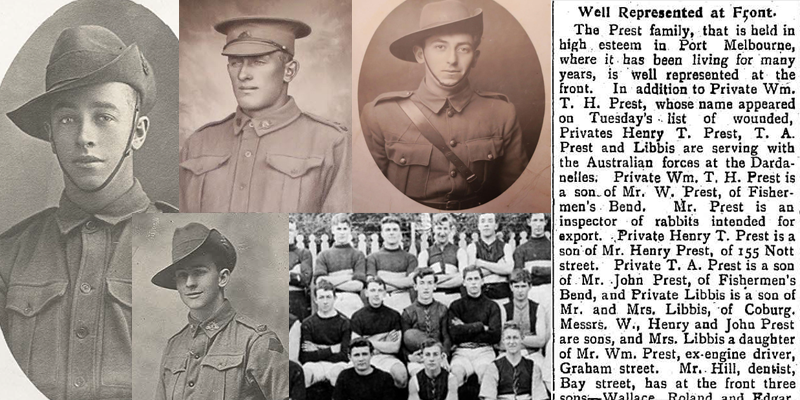Working at Tom Piper
Win May (nee Smith) and Janet Bolitho worked together on this interview during lockdown in August 2021.
Where did you grow up?
My parents moved into our house in Griffin Crescent when it was brand new.
My mother, Mary, worked at Swallows before marrying.
My father, Alex, was a waterside worker who worked in gang 48 as a winch driver. He would walk to the telephone at the corner of Albert and Graham Street each night to find out if he had work the next day. It may be day shift, twilight shift or maybe the midnight shift.
Our house backed onto the laneway and sometimes Mrs Butcher at the dairy would come up to pass on a telephone message for my father.
Port Melbourne was a waterfront workers’ town.
My father had been a merchant seaman and he often spoke of working on the boats to Launceston and ‘Frisco’ (San Francisco). He told me that during the war, the ships had to be blacked out travelling at night time.
There were bad/hard times. I remember my father did not earn any money when the watersiders went on strike and my parents were thankful for the assistance of my grandmother who lived in Albert Street. During a gas strike my father got a small camp stove for my mother to cook on in the backyard. My mother had a ration book with coupons and I would be sent to McLennan’s the grocer and given a number of coupons to hand over to bring home butter, sugar etc.
We’d be listening to the radio at night when the lights would suddenly go out and my mother would have to find a shilling in the dark to put in the meter for the lights to go back on.
The children played chasey, football and cricket in the street, using the lamp post as the stumps and would play outside until called in by parents when it got dark.
Swans/Port Melbourne footballer, Bobby Skilton also lived in Griffin Crescent. His father was a POW and I remember the banners on the front of his house, to welcome him when he came home.
How did you come to work at Tom Piper?
I was Dux of St Joseph’s and it was expected that I would go to Kilbride. But I didn’t want my mother to have the expense of a Kilbride uniform*. My sister, Margaret Smith, worked as a typist at Malcolm Moore and I just wanted to work in an office. As I was only 14, my mother had to get special permission from the government for me to enrol at Stott’s Business College. I did full days of bookkeeping, shorthand and typing. I learned Pitman’s Shorthand and passed with 120 words per minute and typed 45 words a minute. When I had completed the course, my mother went across Williamstown Rd to Tom Piper to ask if they had any vacancies. I was 15 then and it was in 1956.
Can you tell us a bit about Tom Piper?
Tom Piper originally came from Gardenvale in about 1955. It took over Brookes Lemos, producers of cordial, canned fruit and dried mixed fruits. A W Spooner was chairman and his brother, Norman, was the Managing Director. Several of the directors from Brookes Lemos were appointed to the Tom Piper board. The office staff included personnel from both companies. The Brookes Lemos products were then produced under the Tom Piper Brand. The Tom Piper office was built in front of the Brookes Lemos factory.
What did your work involve?
I worked at Tom Piper from 1956 to 1968. Following my mother’s enquiry, I was interviewed and offered a job typing invoices. I then typed cheques in the accounts department and from there went on to the shipping department typing bills of lading, before becoming private secretary/personal assistant to the export manager, Ken Eastaugh, who was later appointed international director.
Ken Eastaugh would dictate his correspondence to me, which I would transcribe from my shorthand notes and type up to send to our overseas agents. Cablegrams would be received from our agents for orders and I would take these down in shorthand over the phone. Ken Eastaugh would be away visiting our overseas agents for 2 to 3 months at a time. I didn’t have much to do with the factory except when he was away. If we received a large order, I would check with the production manager to ensure we had enough stock in hand.
This was a very happy time for me when I worked with Ken Eastaugh. Part of my job was to apply for his visas when he was planning a trip to visit our overseas agents.
I typed up Ken Eastaugh’s correspondence on an IBM electric typewriter with changeable golf balls for the different fonts. It was quite exciting for me at the time and work mates would come into my office to have a look at it – quite a step up from the old manual typewriter!
The Tea Lady
Arch Spooner did not have an office, but would hold meetings in the boardroom. There was a kitchen next to the boardroom, where the tea lady Mrs Freeman, would bake delicious sponges/cakes. At morning and afternoon tea time, she would wheel the trolley down the passage, stopping at each office to bring in your tea/coffee accompanied by a biscuit, or slice of cake if we were lucky enough that she had baked that day. At the end of the passage, she would then leave the trolley in the general office for the staff to help themselves. From time to time, Arch would bring his mother in with him and in school holidays, Barry his son, would accompany them.
What products did they make at Tom Piper?
Some of the products were plum puddings, camp pie, Irish stew and canned fruit in season included apricots in December, peaches sliced or halved in January and pears in February. Many local women worked in the factory during the fruit season. In addition to the domestic market, Tom Piper exported large quantities of products to countries including UK, Malta, Cyprus, Syria, Lebanon, Philippines, Papua New Guinea.

When I retired to start my family, I was given an afternoon tea in the boardroom and presented with a beautiful large camphor chest for the storage of sheets and blankets.
We lived in Nott Street until we were ready to build our house and for six months I worked at Wormalds with June Bonnett and Verdun Howell, the 1959 Brownlow medallist.
* Win was very emphatic on this point, repeating it several times.
Source
Australian Women’s Weekly (1933 – 1982), p. 42. Retrieved October 22, 2021, from http://nla.gov.au/nla.news-article47245856
You might also be interested in another article on Tom Piper on our website and the comments below.




2 Comments
Scott
I was going through my late mother’s stuff and I found her Tom Piper badge in mint condition as well as some references written by the company when she was seeking accommodation at the YWCA. Her name was Yvonne Drew and she worked in the Costing Department around the same time as the woman interviewed above
David Thompson
That’s fantastic Scott. What a fantastic keepsake. Thanks for sharing.